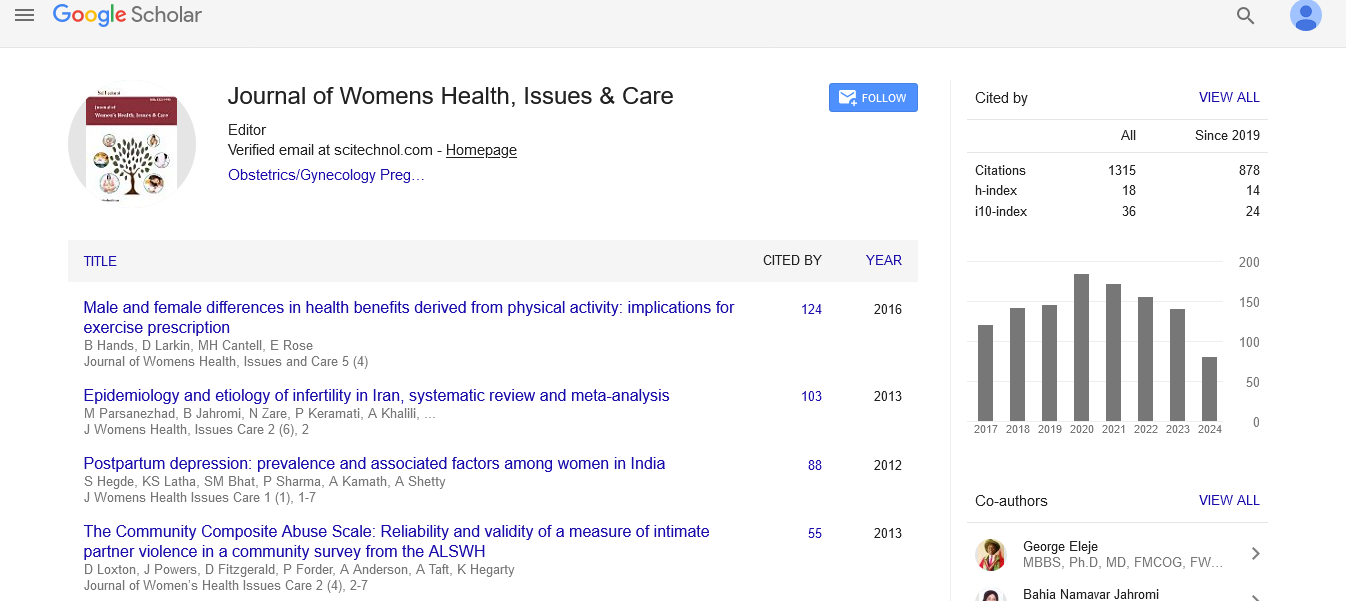Cervical cytology as an aid in diagnosis of sexually transmitted diseases in low middle income group countries (LMIC) like India
Nandini N.M
JSS Academy of Higher Education and Research, India.
: J Womens Health, Issues Care
Abstract
Statement of the problem: vical cancer is the fourth most frequently diagnosedcancer and the fourth leading cause of cancer death in women, with an estimated 604,000 new cases and 34200 deaths worldwide in 2020. Human papillomavirus (HPV) is a necessary but not sufficient cause of cervical cancer. Other important cofactors include some sexually transmittable infections (HIV and Chlamydia trachomatis), smoking, a higher number of childbirths, and long term use of oral contraceptives. Cervical cancer is considered nearly completely preventable because of the highly effective primary (HPVvaccine) and secondary (screening) prevention measures. However, these measures have not been equitably implemented across and within countries. Sexually transmitted infections (STIs) are a major public health problem in developing countries,and treatment with the right medicine at the right time is necessary to reduce transmission and improve sexual and reproductive health. Laboratory diagnosis has undergone changes in the recent years. The new generation tests are not costâ??effective in resourceâ??poor settings. Methodology and Theoretical Orientation: Papanicolaou smear (Pap smear) of the cervix is a simple, quick, and inexpensive screening procedure for cervical cancer that can also give a clue to the presence of STIs. Pap smear also helps in detecting or at least gives a clue to the presence of STIs such as trichomoniasis, Candida, Actinomyces, herpes simplex virus (HSV), cytomegalovirus, and human papillomavirus (HPV). Since India belongs to the LMIC group of countries it has centres which follow good screening programs in cities while rural areas still lack the facilities. In addition poverty and ignorance has led to mortality and morbidity of the women There is thus a need of creating awareness of the various low cost facilities available. Findings: Conventional pap smear has been the norm for screening cervical cancers, it has its limitations with presence of obscuring factors like blood mucus and inflammatory cells which reduces the detection of malignancies. This we overcame by using low cost manual liquid based cytology method (MLBC) which makes the cells form a monolayer and removes the obscuring factors. It helps in performing ancillary techniques like HPV testing and cell block and biomarkers likr p16 which help in increasing the diagnostic accuracy. The lated concept of vaginal microflora playing a role in increasing the incidence of cervical cancer in poor hygiene women of LMIC countries has been worked on which enhances the action of HPV virus We are showcasing our studies done over 10 year period on various methods of cervical cancer study. Conclusion and significance: Sexually transmitted diseases can be detected by conventional pap smears (CPS) along with help of other tests like MLBC, with its ancillary techniques like HPV testing and cell block and biomarkers likr p16 which help in increasing the diagnostic accuracy. This helps to prevent and control the predilection to precancer and cervical cancer in LMIC.
Biography
Dr Nandini N. M, Professor, JSS Medical College, Mysore, is attached as a teaching faculty from the past 25 years in the department of pathology .she has finished her MBBS from JNMC BELGAVI, MD from mysore medical college. She has worked in the field of cytology of cervix and breast. She has attended and given talks at many national and international conferences in countries like U.K, USA, Singapore and Netherland. She has worked on liquid based cytology, cell block technique and has come up with indegenious methods. She has severeal publications and books to her credit written on cervical and breast cancer.
 Spanish
Spanish  Chinese
Chinese  Russian
Russian  German
German  French
French  Japanese
Japanese  Portuguese
Portuguese  Hindi
Hindi 



